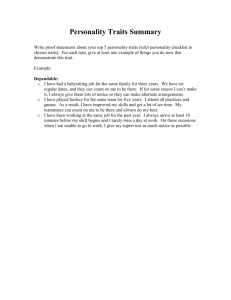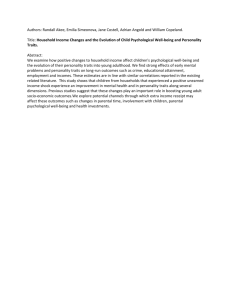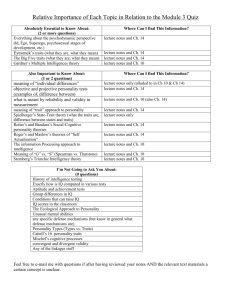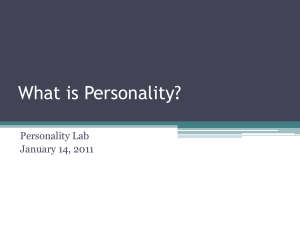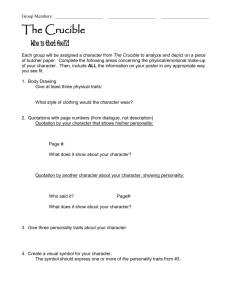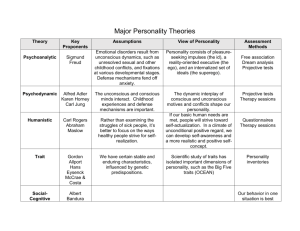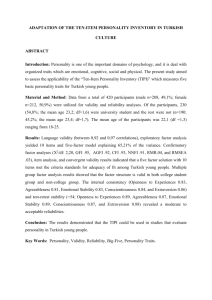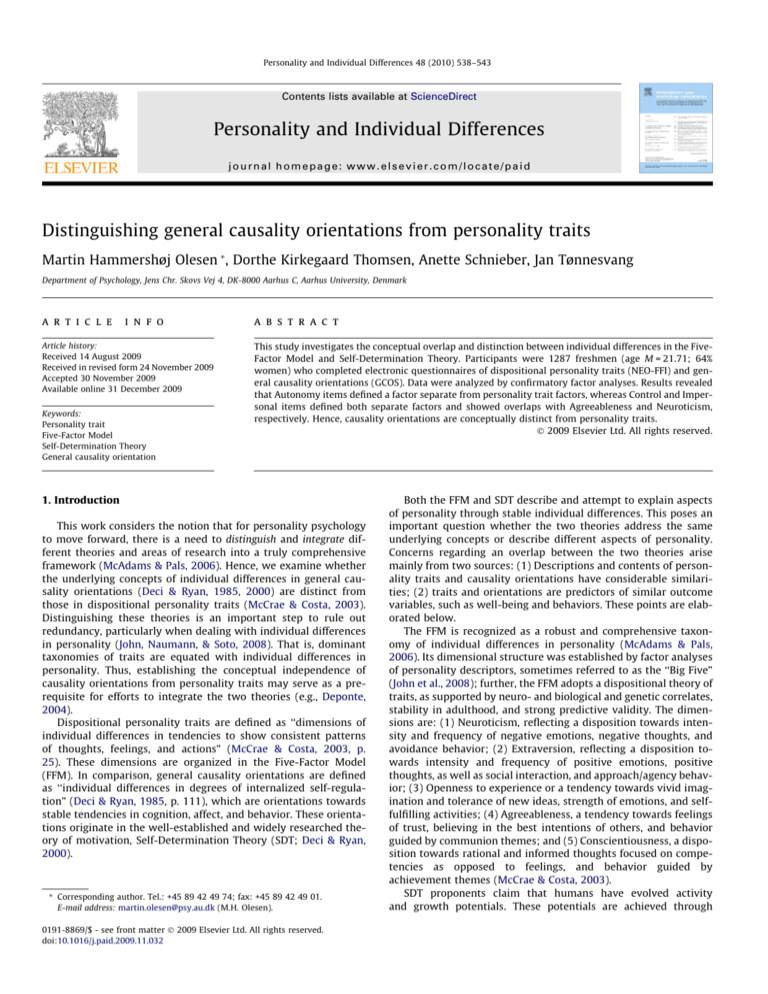
Personality and Individual Differences 48 (2010) 538–543
Contents lists available at ScienceDirect
Personality and Individual Differences
journal homepage: www.elsevier.com/locate/paid
Distinguishing general causality orientations from personality traits
Martin Hammershøj Olesen *, Dorthe Kirkegaard Thomsen, Anette Schnieber, Jan Tønnesvang
Department of Psychology, Jens Chr. Skovs Vej 4, DK-8000 Aarhus C, Aarhus University, Denmark
a r t i c l e
i n f o
Article history:
Received 14 August 2009
Received in revised form 24 November 2009
Accepted 30 November 2009
Available online 31 December 2009
Keywords:
Personality trait
Five-Factor Model
Self-Determination Theory
General causality orientation
a b s t r a c t
This study investigates the conceptual overlap and distinction between individual differences in the FiveFactor Model and Self-Determination Theory. Participants were 1287 freshmen (age M = 21.71; 64%
women) who completed electronic questionnaires of dispositional personality traits (NEO-FFI) and general causality orientations (GCOS). Data were analyzed by confirmatory factor analyses. Results revealed
that Autonomy items defined a factor separate from personality trait factors, whereas Control and Impersonal items defined both separate factors and showed overlaps with Agreeableness and Neuroticism,
respectively. Hence, causality orientations are conceptually distinct from personality traits.
Ó 2009 Elsevier Ltd. All rights reserved.
1. Introduction
This work considers the notion that for personality psychology
to move forward, there is a need to distinguish and integrate different theories and areas of research into a truly comprehensive
framework (McAdams & Pals, 2006). Hence, we examine whether
the underlying concepts of individual differences in general causality orientations (Deci & Ryan, 1985, 2000) are distinct from
those in dispositional personality traits (McCrae & Costa, 2003).
Distinguishing these theories is an important step to rule out
redundancy, particularly when dealing with individual differences
in personality (John, Naumann, & Soto, 2008). That is, dominant
taxonomies of traits are equated with individual differences in
personality. Thus, establishing the conceptual independence of
causality orientations from personality traits may serve as a prerequisite for efforts to integrate the two theories (e.g., Deponte,
2004).
Dispositional personality traits are defined as ‘‘dimensions of
individual differences in tendencies to show consistent patterns
of thoughts, feelings, and actions” (McCrae & Costa, 2003, p.
25). These dimensions are organized in the Five-Factor Model
(FFM). In comparison, general causality orientations are defined
as ‘‘individual differences in degrees of internalized self-regulation” (Deci & Ryan, 1985, p. 111), which are orientations towards
stable tendencies in cognition, affect, and behavior. These orientations originate in the well-established and widely researched theory of motivation, Self-Determination Theory (SDT; Deci & Ryan,
2000).
* Corresponding author. Tel.: +45 89 42 49 74; fax: +45 89 42 49 01.
E-mail address: martin.olesen@psy.au.dk (M.H. Olesen).
0191-8869/$ - see front matter Ó 2009 Elsevier Ltd. All rights reserved.
doi:10.1016/j.paid.2009.11.032
Both the FFM and SDT describe and attempt to explain aspects
of personality through stable individual differences. This poses an
important question whether the two theories address the same
underlying concepts or describe different aspects of personality.
Concerns regarding an overlap between the two theories arise
mainly from two sources: (1) Descriptions and contents of personality traits and causality orientations have considerable similarities; (2) traits and orientations are predictors of similar outcome
variables, such as well-being and behaviors. These points are elaborated below.
The FFM is recognized as a robust and comprehensive taxonomy of individual differences in personality (McAdams & Pals,
2006). Its dimensional structure was established by factor analyses
of personality descriptors, sometimes referred to as the ‘‘Big Five”
(John et al., 2008); further, the FFM adopts a dispositional theory of
traits, as supported by neuro- and biological and genetic correlates,
stability in adulthood, and strong predictive validity. The dimensions are: (1) Neuroticism, reflecting a disposition towards intensity and frequency of negative emotions, negative thoughts, and
avoidance behavior; (2) Extraversion, reflecting a disposition towards intensity and frequency of positive emotions, positive
thoughts, as well as social interaction, and approach/agency behavior; (3) Openness to experience or a tendency towards vivid imagination and tolerance of new ideas, strength of emotions, and selffulfilling activities; (4) Agreeableness, a tendency towards feelings
of trust, believing in the best intentions of others, and behavior
guided by communion themes; and (5) Conscientiousness, a disposition towards rational and informed thoughts focused on competencies as opposed to feelings, and behavior guided by
achievement themes (McCrae & Costa, 2003).
SDT proponents claim that humans have evolved activity
and growth potentials. These potentials are achieved through
M.H. Olesen et al. / Personality and Individual Differences 48 (2010) 538–543
satisfaction of basic psychological needs: Specifically, the need for
autonomy, feeling that one’s behavior is self-organized and valued;
the need for competence, feeling that one is capable, confident, and
effective; and the need for relatedness, feeling that one is connected in relationships and communities (Deci & Ryan, 2000).
SDT argues that humans experience social environments as needfacilitating or need-thwarting, and that these experiences develop
into enduring individual differences in internalized self-regulation,
namely general causality orientations (Deci & Ryan, 1985).
Individual differences in degrees of internalized self-regulation
are operationalized in the General Causality Orientation Scale
(GCOS; Deci & Ryan, 1985), which contains three dimensions that
have been well-validated in prior research: (1) The Autonomy causality orientation (Autonomy), referring to a tendency towards high
degrees of internalized self-regulation, such as experiencing
behavior and choices as free and volitional and in accordance with
one’s own standards and beliefs; (2) the Control causality orientation (Control), referring to a tendency towards low degrees of internalized self-regulation, such as experiencing behavior and choices
as conflicted and pressured by imperatives in social norms and cultural values; and (3) the Impersonal causality orientation (Impersonal), referring to a tendency towards lacking degrees of
internalized self-regulation, such as experiencing behavior and
choices as inefficient, incomprehensible, and beyond intentional
control.
To our knowledge, only one previous study has directly investigated the relationship between individual differences in the FFM
and SDT (Deponte, 2004). The study applied the NEO-Five Factor
Inventory (NEO-FFI) and the GCOS to a sample of 101 Italian students. Autonomy correlated with Extraversion and Agreeableness,
Control correlated with reversed Agreeableness, and Impersonal
correlated primarily with Neuroticism but also with reversed
Extraversion and reversed Conscientiousness. Another study found
no associations between Autonomy and traits, but confirmed that
‘‘reactive autonomy”, a concept similar to Control, was correlated
primarily with reversed Agreeableness but also with Extraversion
and Openness (Koestner & Losier, 1996). In addition, other studies
have found that ‘‘authenticity” (Sheldon, Ryan, Rawsthorne, &
Ilardi, 1997) and ‘‘autonomy support” (La Guardia & Ryan, 2007;
Lynch, La Guardia, & Ryan, 2009), which are conceptually similar
to Autonomy, were correlated with Extraversion, Openness, Agreeableness, and Conscientiousness, as well as reversed Neuroticism.
However, correlational associations (e.g., Deponte, 2004), may
also suggest that personality traits and causality orientations are
referring to the same underlying concepts of individual differences,
especially if the correlations are sufficiently high (Asparouhov &
Muthén, 2009; Jöreskog, Sörbom, Du Toit, & Du Toit, 2001).
To investigate this question, we apply confirmatory factor analysis
(CFA). Below, we explain the traits with which each of the
three causality orientations is expected to share conceptual
underpinnings.
Autonomy, as an orientation, may share conceptual underpinnings with Extraversion and Agreeableness. Both Autonomy and
Extraversion encompass well-being, activity, and engagement in
social interaction, and both Autonomy and Agreeableness
encompass trust and honesty in social relations (Deci & Ryan,
1985; McCrae & Costa, 2003). In empirical studies, Autonomy
(Deci & Ryan, 1985, 2000) and Extraversion (DeNeve & Cooper,
1998; McCrae & Costa, 1991) predict well-being states. Autonomy predicts honesty and taking responsibility during disclosure
(Hodgins, Yacko, & Gottlieb, 2006). Similarly, Agreeableness predicts using negotiation in resolving conflicts (Jensen-Campbell
et al., 2002).
Control may share conceptual underpinnings with reversed
Agreeableness. Both Control and low Agreeableness encompass
defensive aggression and hostility as well as dishonesty in social
539
relationships (Deci & Ryan, 1985; McCrae & Costa, 2003). In empirical studies, Control predicts aggressive behavior during disclosure
(Hodgins et al., 2006). Similarly, low Agreeableness predicts using
power in attempts to resolve conflicts (Jensen-Campbell et al.,
2002).
Impersonal may share conceptual underpinnings with Neuroticism. Both encompass negative well-being, helplessness, and
avoidance behavior (Deci & Ryan, 1985; McCrae & Costa, 2003).
In empirical studies, Impersonal (Deci & Ryan, 1985, 2000) and
Neuroticism (DeNeve & Cooper, 1998; McCrae & Costa, 1991) predict negative well-being states. Impersonal predicts defensive and
avoidance behavior during disclosure (Hodgins et al., 2006). Similarly, Neuroticism predicts defensive and avoidance behavior (Jensen-Campbell et al., 2002).
To test the predictions an exploratory CFA strategy was
adopted. This is because it is unclear which of the correlations
(e.g., Deponte, 2004) and content overlaps might refer to the same
underlying individual differences constructs, and hence be better
explained by either shared or separate latent variables. In such a
case, a restricted CFA strategy would test several alternative models, which is inherently an exploratory procedure (Jöreskog et al.,
2001). Thus, to limit the number of models tested, we specified
models that combine zero cross-loading indicators for personality
traits with cross-loading indicators for causality orientations as
shown in Fig. 1. Personality trait factors then define the structure
of the models as in restricted CFA and in accordance with
the well-established FFM theory. Simultaneously, the causality
orientation indicators are allowed to map freely onto both personality trait and causality orientation factors as in exploratory factor
analysis. This procedure is advantageous to restricted CFA, when
zero cross-loading indicators cannot be assumed (Asparouhov &
Muthén, 2009), while fit statistics and significance levels for all
loadings are provided.
2. Method
2.1. Participants
Participants were 1287 students who enrolled at the University
of Aarhus in Denmark in August 2007. This sample was representative for the 3738 students enrolling that semester in terms of
age (M = 21.72, SD = 4.43, t(3725) = .99, p < .32). However, women were overrepresented among responders (828 women vs.
457 men and two unidentified among responders and 1304 women vs. 1138 men and nine unidentified among non-responders,
v2(1) = 41.90, p < .001).
2.2. Recruitment
Participants were recruited in cooperation with the University
Registrar’s Office. The Registrar sent out an official welcome e-mail
to all newly admitted students. The e-mail briefly introduced a
self-service portal and invited students to participate in the research project.
2.3. Materials
Personality traits were measured by the Danish translation of
the NEO-FFI (Costa & McCrae, 2003). NEO-FFI consists of 60 items,
which assess the five trait dimensions. Participants were asked to
rate general personality statements on 5-point Likert scales ranging from strongly disagree to strongly agree. Internal reliability for
the NEO-FFI subscales can be seen in Table 1.
General causality orientations were measured by the extended
version of the GCOS (Deci & Ryan, 1985; Ryan, 1989), which had
540
M.H. Olesen et al. / Personality and Individual Differences 48 (2010) 538–543
gcos1 a,b, or c
1
Autonomy,
Control, or
Impersonal
gcos… a,b, or c
gcos17 a,b, or c
facet N1
1
N
facet…
facet N6
facet E1
1
E
facet E…
facet E6
facet O1
1
O
facet O…
facet O6
facet A1
1
A
facet A…
facet A6
facet C1
1
C
facet C…
facet C6
Fig. 1. The general model. Factors were scaled using unit loading identification constraints and the covariances between causality orientation and personality trait factors
were set to zero. N = Neuroticism; E = Extraversion; O = Openness; A = Agreeableness; C = Conscientiousness.
teristic to very characteristic. Internal reliability for the GCOS subscales can be seen in Table 1.
Table 1
Means, standard deviations and Cronbach’s a for NEO-FFI and GCOS.
NEO-FFI and GCOS
M
SD
a
Neuroticism
Extraversion
Openness
Agreeableness
Conscientiousness
Autonomy
Control
Impersonal
23.49
31.37
31.07
29.88
31.73
101.06
69.45
34.31
7.53
6.82
6.50
6.38
6.62
8.32
10.77
13.48
.82
.82
.74
.75
.82
.78
.70
.82
Note: N = 1287. NEO-FFI = NEO Five-Factor Inventory. GCOS = General Causality
Orientation Scale.
been translated into Danish, in a previous study (Thomsen,
Tønnesvang, Schnieber, & Olesen, submitted for publication, study
1). This GCOS version consists of 17 short vignettes with 51 items.
Each vignette (e.g., having just been turned down for a job) is followed by three prototypical responses, which assess Autonomy,
Control, and Impersonal respectively. Participants were asked to
rate responses on 7-point Likert scales ranging from very uncharac-
2.4. Procedure
The Registrar’s e-mail provided a link to a set of electronically
administered personality and motivation questionnaires (and
packages of other questionnaires not relevant to the present
study). Reminder e-mails were sent out after approximately two
weeks to non-responding students. Questionnaires were closed
after one month. Note that the software was set not to accept missing data. Participants who completed all packages of questionnaires were rewarded with a standard personality trait profile.
Thus, 589 profiles were sent out after three months.
2.5. Analysis
A model for each of the causality orientations was specified and
estimated by maximum likelihood using LISREL 8.8 (Jöreskog et al.,
2001) based on sample variances and covariances. To obtain a
manageable number of observed variables the NEO-FFI items were
541
M.H. Olesen et al. / Personality and Individual Differences 48 (2010) 538–543
Table 2
Pearson’s correlations between NEO-FFI and GCOS.
GCOS
NEO-FFI
N
Autonomy
Control
Impersonal
Table 3
Standardized cross- and primary loadings (p < .001), and eigenvalue k for GCOS
Autonomy items.
E
.09
.05
.52*
O
*
.33
.16*
.48*
A
*
.35
.10
.20*
GCOS Autonomy items
C
*
.26
.44*
.10*
NEO-FFI
*
.22
.01
.15*
Note: N = 1287. Correlations above .30 are given in boldface. NEO-FFI = NEO FiveFactor Inventory. N = Neuroticism; E = Extraversion; O = Openness; A = Agreeableness; C = Conscientiousness. GCOS = General Causality Orientations Scale.
*
p < .001.
parceled, two items per observed variable, in accordance with the
second order facet level in the FFM hierarchy1 (Costa & McCrae,
2003). The respective Autonomy, Control, or Impersonal items in
each model were not parceled nor restrained, meaning that GCOS
items were set to indicate both the five personality factors and a
sixth factor. If causality orientation items loaded significantly on
the personality trait factors it would be supportive of a conceptual
overlap (Asparouhov & Muthén, 2009; Jöreskog et al., 2001);
whereas if causality orientation items loaded significantly on their
own respective factors, it would be supportive of a conceptual distinction. The general model is presented in Fig. 1.
The eigenvalue k (sums of squared loadings) for GCOS items on
each personality trait and causality orientation factor measures the
relative contribution of variance explained by each factor. Several
goodness-of-fit indices were used to evaluate the models before
interpreting GCOS loadings: Chi-square test, root means square error of approximation with 90% confidence intervals (RMSEA; Steiger, 1990), comparative fit index (CFI; Bentler, 1990), and
standardized root mean square residual (SRMR; Jöreskog et al.,
2001). Acceptable fits are indicated by a non-significant chi-square,
CFI values >.90, RMSEA values <.08 and SRMR values <1.00 (Hu &
Bentler, 1999).
3. Results
Means and standard deviations for NEO-FFI traits and GCOS orientations are reported in Table 1, and correlations between them
are reported in Table 2. The results were generally in agreement
with expectations from previous studies (e.g., Deponte, 2004). A
few small correlations turned out significant, presumably due to
the large N.
The first model tested whether Autonomy shared underpinnings with Extraversion and Agreeableness as well as other personality traits. The model provided a reasonably good fit to the data
(v2(939) = 4976.08, p < .001; RMSEA = .058 [.056; .059]; CFI = .89;
SRMR = .067). Generally, primary loadings (p < .001) of GCOS
Autonomy items were on the Autonomy factor as expressed in
the eigenvalue, k = 1.88 (Table 3). There were a few exceptions
and small cross-loadings (e.g., gcos6b; gcos12a, and gcos14c),
mostly on the factors of Extraversion, k = .45 and Openness,
k = .50. This result suggests that Autonomy is conceptually distinct
from FFM traits.
The second model tested whether Control shared underpinnings with Agreeableness and other personality traits. The model
provided a reasonably good fit to the data (v2(939) = 5324.43,
p < .001; RMSEA = .060 [.059; .062]; CFI = .86; SRMR = .066). The
majority of primary loadings (p < .001) of GCOS Control items were
on the Control factor, k = 1.36 (Table 4). However, there were
exceptions and cross-loadings (e.g., gcos2a, gcos5c, gcos6a, gcos7a,
1
The Danish translation of NEO-FFI consists of the two items with the highest
second order facet-loadings (30 pairs) from the NEO Personality Inventory – Revised.
gcos1c
gcos2c
gcos3a
gcos4b
gcos5b
gcos6b
gcos7c
gcos8c
gcos9b
gcos10b
gcos11a
gcos12a
gcos13a
gcos14c
gcos15a
gcos16a
gcos17a
gcos k
GCOS
N
E
O
A
C
Autonomy
.14
–
–
–
–
–
–
.14
.14
–
–
.13
–
–
–
–
–
.12
–
–
–
.26
.43
–
–
–
.16
.23
–
–
–
.22
.15
.17
.15
.14
.12
–
–
.10
–
–
.15
.17
–
.33
.20
.34
.18
.22
.19
–
.13
.18
–
.18
–
.19
–
–
.17
–
–
.11
.20
.16
.14
–
–
–
–
.19
.12
–
–
.17
–
–
–
–
.18
.15
.12
.15
–
.22
.30
.29
.24
.32
.19
.37
.36
.36
.45
.29
.27
.43
.26
.42
.38
.36
.08
.45
.50
.24
.17
1.88
Note: N = 1287. Primary loadings are given in boldface, non-significant loadings are
omitted. NEO-FFI = NEO Five-Factor Inventory. N = Neuroticism; E = Extraversion;
O = Openness; A = Agreeableness; C = Conscientiousness. GCOS = General Causality
Orientations Scale.
Table 4
Standardized cross- and primary loadings (p < .001), and eigenvalue k for GCOS
Control items.
GCOS Control items
NEO-FFI
GCOS
N
E
O
A
gcos1b
gcos2a
gcos3b
gcos4c
gcos5c
gcos6a
gcos7a
gcos8b
gcos9c
gcos10a
gcos11b
gcos12b
gcos13c
gcos14a
gcos15c
gcos16c
gcos17c
–
–
–
–
–
–
–
–
–
–
–
–
–
–
–
–
–
.14
–
–
–
.24
.36
.17
–
.20
–
.21
.19
–
–
–
–
–
.12
–
–
–
–
–
–
–
–
–
–
.22
.15
–
–
.15
–
gcos k
0
.36
.11
C
Control
.24
.21
.17
.14
.34
–
32
.20
.32
.25
.26
.15
.13
.21
.16
.19
.28
–
–
–
–
.12
–
–
–
–
–
–
.13
–
–
–
–
–
.50
.14
.21
.16
.23
.14
–
.23
.52
.26
.49
.19
.27
–
.26
.29
.24
.86
.03
1.36
Note: N = 1287. Primary loadings are given in boldface, non-significant loadings are
omitted. NEO-FFI = NEO Five-Factor Inventory. N = Neuroticism; E = Extraversion;
O = Openness; A = Agreeableness; C = Conscientiousness. GCOS = General Causality
Orientations Scale.
gcos12b, gcos14a, and gcos17c), consistently on the Agreeableness
factor, k = .86. This result suggests that Control is somewhat overlapping with Agreeableness, but predominantly distinct from FFM
traits.
The third model tested whether Impersonal shared underpinnings with Neuroticism and other personality traits. The model
provided a reasonably good fit to the data (v2(939) = 5435.74,
p < .001; RMSEA = .061 [.059; .063]; CFI = .91; SRMR = .072). Significant cross- and primary loadings (p < .001) of GCOS Impersonal
items were on both the Impersonal factor, k = 1.76 as well as the
Neuroticism factor, k = 2.04 (Table 5). There were only a few exceptions and cross-loadings (e.g., gcos5a and gcos6c), mostly on the
Extraversion factor, k = .63. This result suggests that some aspects
of Impersonal are conceptually distinct from FFM traits, whereas
542
M.H. Olesen et al. / Personality and Individual Differences 48 (2010) 538–543
Table 5
Standardized cross- and primary loadings (p < .001), and eigenvalue k for GCOS
Impersonal items.
GCOS Impersonal items
NEO-FFI
GCOS
N
E
O
A
C
gcos1a
gcos2b
gcos3c
gcos4a
gcos5a
gcos6c
gcos7b
gcos8a
gcos9a
gcos10c
gcos11c
gcos12c
gcos13b
gcos14b
gcos15b
gcos16b
gcos17b
.53
.49
.20
.71
.12
.23
.26
.43
.51
–
.11
.59
.19
–
–
–
–
–
–
–
–
.31
.51
.13
–
–
.21
–
–
–
.19
.31
.22
.17
.13
.22
–
.15
.16
–
.21
.20
.21
.17
.23
–
.26
–
–
.14
–
.31
.25
.16
.15
–
–
–
.14
.24
–
.10
.11
.21
–
.15
.15
–
–
–
–
gcos k
2.04
.63
.41
.40
Impersonal
.26
.17
.28
.10
.19
.18
.40
.21
.29
.43
.26
.13
–
.12
.11
–
.12
–
.11
.13
.13
–
.17
.16
–
.16
–
.28
.46
.56
.40
.45
1.76
Note: N = 1287. Primary loadings are given in boldface, non-significant loadings are
omitted. NEO-FFI = NEO Five-Factor Inventory. N = Neuroticism; E = Extraversion;
O = Openness; A = Agreeableness; C = Conscientiousness. GCOS = General Causality
Orientations Scale.
other aspects of Impersonal are conceptually overlapping with
Neuroticism.
To test whether general causality orientations could be distinguished from dispositional personality traits in a restricted CFA,
we specified a fourth model. That is, a subsequent model, in which
the NEO-FFI parcels and GCOS-item indicators were restrained to
zero cross-loadings on eight distinct factors. A reasonably good
fit to the data would support a conceptual distinction between
all three orientations and traits. The fourth model provided a reasonably good fit to the data (v2(3131) = 18220.69, p < .001;
RMSEA = .061 [.060; .062]; CFI = .85; SRMR = .078). All loadings
were significant (p < .001; range for NEO-FFI parcels [.35; .80],
mean = .58; range for GCOS items [.12; .61], mean = .41). This result provides additional support that causality orientations are distinct from personality traits.
4. Discussion
This study is the first to investigate the conceptual overlap and
distinction between individual differences in the FFM and SDT. We
conducted exploratory CFA of self-reported measures of dispositional personality traits (NEO-FFI) and general causality orientations (GCOS) applied to a large sample of Danish students. The
results indicate that Autonomy and aspects of both Control and
Impersonal address individual differences in personality that are
not captured by the FFM traits. This was confirmed by a subsequent CFA model, in which all three causality orientations were
distinguished from personality traits.
Autonomy as measured by GCOS appears to be a unique concept of individual differences in personality. One central difference
is that Autonomy encompasses an internal perceived locus of causality (Deci & Ryan, 1985); that is an understanding of the causes
and reasons for one’s behavior in social relations. This is supported
by studies showing that the free initiation of behavior and volitional choice, as encompassed by Autonomy, predict consistency
between attitudes, traits, and behavior (Koestner, Bernieri, & Zuckerman, 1992), also referred to as a strong self-integration (Hodgins
& Knee, 2002), and an authentic self (Sheldon et al., 1997), or an
autonomy-supportive personality (LaGuardia & Ryan, 2007).
Since Autonomy is clearly distinct from personality traits, this
opens up the possibility for integrative efforts and calls for research on the relationship between Autonomy and personality
traits. It is possible that Extraversion, Openness, Agreeableness
and Conscientiousness dispose individuals to experience social
environments as need-facilitating, and thus they develop into
Autonomous persons. In this understanding, Autonomy would belong to the personality domain of characteristic adaptations; that is
motivational, social-cognitive, and developmental adaptations of
dispositional traits that in contrast to traits are shaped by contingencies in social contexts (McAdams & Pals, 2006; McCrae & Costa,
2003). Another possibility is that need-facilitating environments
might independently influence the expression of traits and the
development of Autonomy. A third possibility is that Autonomy
may cause positive trait expressions of Extraversion, Agreeableness, Openness, and Conscientiousness (La Guardia & Ryan, 2007;
Lynch et al., 2009; Sheldon et al., 1997). These are empirical questions awaiting further research.
Control as measured by GCOS also appears to be a predominantly unique concept of individual differences in personality.
One might argue that Control items showed consistent cross-loadings on the Agreeableness factor, but the relative contribution here
was low. Also Control was distinguished in the subsequent eightfactor CFA model. Hence, the Control concept is distinguishable
from Agreeableness (e.g., Deponte, 2004). One central difference
is that Control encompasses an external perceived locus of causality (Deci & Ryan, 1985); that is a simple and rule-based understanding of the causes and reason of one’s behavior in social
relations. However, Control is closely related to Agreeableness.
Thus, feelings of distrust and believing in the worst intentions of
others, as encompassed by low Agreeableness, likely contribute
to Control. Likewise, conflicted behavior and pressured choices,
as encompassed by Control, negate Agreeableness.
Impersonal as measured by GCOS appears to be both conceptually distinct from and overlapping with Neuroticism. Though
Impersonal was distinguished from personality traits in a subsequent eight-factor model, one might still argue that the overlapping features in notable cross-loadings are more important.
However, since the theory and psychometrics of Neuroticism are
extremely robust (John et al., 2008) the finding that Impersonal
items defined a separate latent variable is impressive and deserves
further attention.
The Impersonal items that load on the Neuroticism factor seem
to address reactions describing negative affect and experiences of
incompetence. One example is a vignette where the participant is
responding to negative evaluations (gcos4a): ‘‘Think that I can’t
do anything right and feel sad.” Since negative affect is a central
characteristic of Neuroticism, it is hardly surprising that Impersonal items describing negative affect can be explained by
Neuroticism. However, items with primary Impersonal loadings
describe poor coping strategies or perceived helplessness when
attempting to resolve social problems. One example is a vignette
where the participant is responding to angry outbursts of a friend
(gcos15b): ‘‘Ignore it, there is nothing you can do.” Even though
Neuroticism includes aspects of avoidance behavior, Impersonal
seems to focus more specifically on withdrawal from incomprehensible social encounters and situations in which one does not
expect to be able to affect desired outcomes.
Expanding on the item analysis above, one could argue that the
Impersonal concept addresses aspects of individual differences distinct from Neuroticism. One central difference is that Impersonal
encompasses an impersonal perceived locus of causality (Deci &
Ryan, 1985); that is an inability to understand the causes and reasons of one’s behavior. Thus, Impersonal presumes a lack of insight
leading to both incompetence and deficiency of intentional
behavior.
M.H. Olesen et al. / Personality and Individual Differences 48 (2010) 538–543
4.1. Limitations
The primary limitation of the present study is that the sample
consists of university students. Further, the study did not control
for an order-effect of presenting the personality measure first.
Hence, the results should be replicated in a more representative
sample, counterbalancing the questionnaires.
5. Conclusion and perspectives
General causality orientations address aspects of individual differences that are conceptually distinct from personality traits. We
suggest that causality orientations are characteristic adaptations of
dispositional traits (McAdams & Pals, 2006). This proposal has several implications for research in individual differences in personality. First, distinguishing causality orientations from traits provides
a stronger rationale for studies examining how autonomy support
may influence expressions of certain personality traits (e.g.,
LaGuardia & Ryan, 2007; Lynch et al., 2009). In addition, this calls
for integrative research on the relationship between causality orientations and domain specific and situational expressions of traits.
Second, causality orientations may also influence the relationship
between personality and other variables, such as goals, life-stories,
and well-being. For example, it has been found that consistency
between goals, life-stories; and traits is related to higher wellbeing (McGregor, McAdams, & Little, 2006). Following SDT, causality orientations may explain how individuals develop such a
consistency.
Acknowledgements
Thanks to Hans Jørgen Hansen at the Registrar’s Office at Aarhus
University and to Henrik Hansen and Peter Hartmann at the Danish
Psychological Publishers for their collaboration. Also thanks to Edward Deci, Richard Ryan, and Martin Lynch at the University of
Rochester, and to Mark Shevlin at Aarhus University for their comments. The study was supported by a grant to the second and last
author from the Danish Research Council for Culture and Communication (Grant: 273-06-0395).
References
Asparouhov, T., & Muthèn, B. (2009). Exploratory structural equation modeling.
Structural Equation Modeling, 16, 397–438.
Bentler, P. M. (1990). Comparative fit indexes in structural models. Psychological
Bulletin, 107, 238–246.
Costa, P. T., Jr., & McCrae, R. R. (2003). NEO PI-R manual – Clinical (1st ed.). Book
Partner A/S Copenhagen: PsykologiErhverv A/S.
543
Deci, E. L., & Ryan, R. M. (1985). The general causality orientations scale: Selfdetermination in personality. Journal of Research in Personality, 19, 109–134.
Deci, E. L., & Ryan, R. M. (2000). The ‘‘what” and ‘‘why” of goal pursuits: Human
needs and the self-determination of behavior. Psychological Inquiry, 11,
227–268.
DeNeve, K. M., & Cooper, H. (1998). The happy personality: A meta-analysis of 137
personality traits and subjective well-being. Psychological Bulletin, 124,
197–229.
Deponte, A. (2004). Linking motivation to personality: Causality orientations,
motives and self-descriptions. European Journal of Personality, 18, 31–44.
Hodgins, H. S., & Knee, C. R. (2002). The integrating self and conscious experience. In
E. L. Deci & R. M. Ryan (Eds.), Handbook of self-determination research (1st ed.,
pp. 87–101). Rochester: The University of Rochester Press.
Hodgins, H. S., Yacko, H. A., & Gottlieb, E. (2006). Autonomy and nondefensiveness.
Motivation and emotion. Special Issue: Autonomy, Volitional Motivation, and
Wellness, 30, 283–293.
Hu, L., & Bentler, P. M. (1999). Cut-off criteria for fit indexes in covariate structure
analysis: Conventional criteria versus new alternatives. Structural Equation
Modelling, 6, 1–55.
Jensen-Campbell, L. A., Adams, R., Perry, D. G., Workman, K. A., Furdella, J. Q., & Egan,
S. K. (2002). Agreeableness, extraversion, and peer relations in early
adolescence: Winning friends and deflecting aggression. Journal of Research in
Personality, 36, 224–251.
John, O. P., Naumann, L. P., & Soto, C. J. (2008). Paradigm shift to the integrative big
five trait taxonomy. History, measurement, and conceptual issues. In O. P. John,
R. W. Robins, & L. A. Pervin (Eds.), Handbook of personality theory and research
(3rd ed., pp. 114–159). New York: Guilford Press.
Jöreskog, K. G., Sörbom, D., Du Toit, S., & Du Toit, M. (2001). Lisrel 8: New statistical
features (3rd ed.). Lincolnwood, IL: Scientific Software International, Inc.
Koestner, R., Bernieri, F., & Zuckerman, M. (1992). Self-regulation and consistency
between attitudes, traits, and behaviors. Personality and Social Psychology
Bulletin, 18, 52–59.
Koestner, R., & Losier, G. F. (1996). Distinguishing reactive versus reflective
autonomy. Journal of Personality, 64, 465–494.
La Guardia, J. G., & Ryan, R. M. (2007). Why identities fluctuate: Variability in traits
as a function of situational variations in autonomy support. Journal of
Personality, 75, 1205–1228.
Lynch, M., La Guardia, J. G., & Ryan, R. M. (2009). On being yourself in different
cultures: Ideal and actual self-concept, autonomy support, and well-being in
China, Russia and the United States. The Journal of Positive Psychology, 4,
290–304.
McAdams, D. P., & Pals, J. L. (2006). A new big five. Fundamental principles for an
integrative science of personality. American Psychologist, 61(3), 204–217.
McCrae, R. R., & Costa, P. T. Jr., (1991). Adding liebe und arbeit: The full five-factor
model and well-being. Personality and Social Psychology Bulletin, 17, 227–232.
McCrae, R. R., & Costa, P. T. Jr., (2003). Personality in adulthood: A five-factor theory
perspective (2nd ed.). New York: Guilford Press.
McGregor, I., McAdams, D. P., & Little, B. (2006). Personal projects, life-stories and
happiness: On being true to traits. Journal of Research in Personality, 40,
551–572.
Ryan, R. M. (1989). The revised 17-item general causality orientations scale.
Unpublished manuscript, University of Rochester.
Sheldon, K. M., Ryan, R. M., Rawsthorne, L. J., & Ilardi, B. (1997). Trait self and true
self: Cross-role variation in the big five personality traits and its relations with
psychological authenticity and subjective well-being. Journal of Personality and
Social Psychology, 73, 1380–1393.
Steiger, J. H. (1990). Structural model evaluation and modification: An interval
estimation approach. Multivariate Behavioral Research, 25, 173–180.
Thomsen, D. K., Tønnesvang, J., Schnieber, A., & Olesen, M. H. (submitted for
publication). Do people ruminate because they haven’t digested their goals?
Less goal internalization is associated with rumination.

